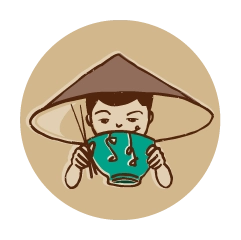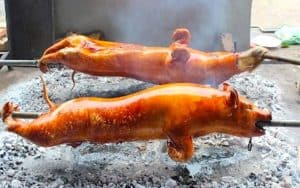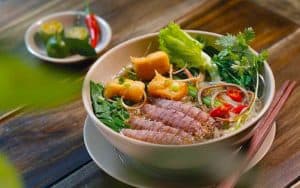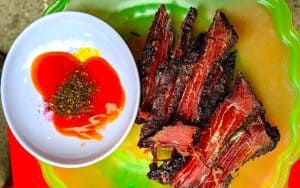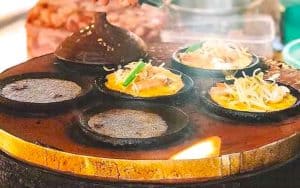The Mekong Delta
Đồng Bằng Sông Mê Kông
With a length of more than 4,500 kilometres, the Mekong Delta has one of the world’s largest rivers. It springs from the eastern Tibetan highlands about 5,200 metres above sea level and flows through China, Myanmar, Laos and Cambodia into Việt Nam and then into the South China Sea. Shortly after entering Việt Nam, the Mekong splits into nine smaller rivers, hence the Vietnamese name of Nine Dragon River (Cửu Long Giang) comes about. These nine rivers, together with countless canals and tributaries, criss-cross the thirteen provinces making up the delta, which once was part of the greater Cambodian empire of the Khmers. In the eighteenth century, Vietnamese forces pushed from Sài Gòn into the delta, drove out the Khmer forces and annexed the region under Việt Nam rule. To this day, a sizeable part of the population is still of Khmer background, and Cambodia regularly demands a return of certain border provinces, but to no avail.
The Mekong (Miền Tây) is home to an amazing variety of fishes, with more than twelve hundred species identified so far. The most popular for the dining table are the cat and elephant fish. Breeding these species on the mobile fish farms is the latest growth industry in the delta. These farms are often not more than a barge with a corrugated iron shed and a three-metre net below where the fish are kept. This type of farming is particularly popular in Cần Thơ province where the currents are just right to provide the necessary nutrients, and fish farms are constantly being towed to different feeding grounds on the river.
Life in the delta revolves around the Mekong – a life force that nourishes not only the provinces of the region but the country as a whole. The river is crowded with boats of all shapes and sizes – small wooden boats rowed standing up, longtail boats propelled by noisy outboards, small houseboats called sampans, which incredibly, are home to extended families, and the squat wooden vessels built for carrying heavy loads.
Laden with mountains of mangoes, jackfruits, pineapples and pomelos, these boats crowd together on early mornings at the Cái Răng Floating Market about six kilometres south of Cần Thơ for business. This is a wholesale market where farmers from the surrounding villages bring their products to sell to stallholders from the smaller local markets throughout the city, or to the food factories on the riverbanks for distribution to the rest of Việt Nam.
Cái Răng Cho Nổi (Floating Market) , Cần Thơ
As heavy rain is falling on the Mekong Delta, flooding the footpaths, swelling in the gutters, turning riverbank mud from light tan to a rich coffee colour. In the villages, everybody runs for cover – men, women, infants, chickens, geese, dogs and cats, all scurrying under iron sheet roofs and looking hopefully up at a slate-grey sky.
It is the rainy season, and ‘water, water everywhere’ might be the job description for the Mekong Delta. A tangled network of rivers, tributaries and canals, the waters of the delta criss-cross the lowlands of southern Việt Nam, before emptying out into the South China Sea through mighty, yawning estuaries. For centuries, life here has ebbed and flowed in tandem with the current of the Mekong – an all-in-one launderette, bathtub, highway, toilet, dishwasher, larder, social club and workplace for the communities surrounded by its waters.
Human life still instinctively congregates on the water’s edge. Lining the riverbank nearby are grocery shops, cafés, a gym, a billiards club and a blacksmith’s, whose owner makes kitchen utensils from helicopter parts left over from the Việt Nam War. Floating markets, too, are still held every morning along the Delta – with creaking barges from across the delta bashing into each other as they offload cargoes of fruits and vegetables.
Cần Thơ is the fourth largest city in Việt Nam and the largest city in the Mekong Delta. The city is nicknamed the “western capital” (Tây Đô) and is located 169 kilometres from Sài Gòn. Cần Thơ’s climate is tropical and monsoonal with two seasons: rainy, from May to November; and dry, from December to April.
Because of this fertile region in Mekong Delta, it’s also known as the “Rice Bowl of Việt Nam,” thrives off of environmental conditions that allow agriculture, livestock and fisheries to flourish for as long as one can remember. It’s home to a unique ecosystem, as well as diverse communities unlike anywhere in the world.
As the capital of the west, Cần Thơ has an extensive list of fruits, vegetables, seafood, which combine to make the best cuisines in the entire region. One major characteristic of Cần Thơ is that every dish has to have rice, which is the region’s finest, and so many herbs that just make lives better.
Cần Thơ is home to a labyrinth of tributaries, lush landscapes, rice farms, mangroves and colourful floating markets. Famed for their fresh vegetables and fish, these local markets pulse with energy and familial vibes. Easily accessible by bus from Saigon, the towns and villages on the Mekong River and its tributaries give you a glimpse of a way of life largely unchanged for centuries.
Cần Thơ City’s Cái Răng Floating Market attracted 200,000-300,000 visitors in the first seven months of the year. Founded in 1739, Cần Thơ has evolved from sovereign state to colonial outpost to what it is today: the de facto capital of the Mekong Delta, the vast, fertile floodplains of southern Việt Nam where the Mekong River splits into a maze of smaller rivers. Cái Răng Floating Market was recognised as the Intangible Cultural Heritage of Việt Nam not long ago. A bazaar of tightly-packed wooden skiffs loaded with fresh tropical produce — pineapples, loganberries, mangoes, papayas, durian, jackfruit, soursop and rambutan among them — that are bartered and sold each morning by local women in conical hats.
Another remarkable experience when visiting Cái Răng Floating Market is having breakfast on a floating boat. The breakfast in the South of Việt Nam is often a bowl of “hủ tiếu”, “bún riêu” (rice noodle with hot soup), “bánh mì” (bread stuffed with vegetables, pork and egg) or “cơm tấm” (broken rice with grilled pork), all of which are prepared in a meticulous way. Cooked with fresh ingredients and delicate broth could satisfy any food-lover’s flavour. And eating on the unbalanced boat on the river certainly made it one of the most exceptional experiences in the Mekong Delta.
Sample regional cuisine is an essential and interesting thing to do in any places that you travel to. Every region has its own specialities and spins on traditional recipes. When in Cần Thơ, don’t miss the local specialities. Some of the most well-known regional dishes are:
Cái Răng Grilled Pork Skewers (Nem nướng Cái Răng)
The best-grilled pork ball skewers are made from the freshest local pork and lard. The meat is finely minced or hand-smashed for hours into a meat paste, then balled, and grilled on charcoal, similar to Yakitori. The meatballs, string by the bamboo skewers, stick together to make a “roll” that is juicy and delicious. Removed from the bamboo stick and you will have perfect and irresistible pork balls to eat with the bánh hỏi, a Vietnamese dish consisting of rice vermicelli woven into intricate bundles and often topped with chopped scallions or garlic chives sautéed in oil. To fully enjoy this delicacy, you need to eat like the locals; with small, local-made rice paper, top with an abundance of fresh young Mekong Delta’s herbs, thinly sliced of young cucumber, sour pineapple, green star fruit, green-young banana, arrange with bánh hỏi and nem nướng and all are rolled to a tight handroll, and the combination is dipped into a peanut-hoisin sauce that is equally amazing. Without the dipping sauce, the rolls are nothing.
Freshwater Snails with Green Peppers (Ốc bươu nướng tiêu xanh)
This simple dish is a mouth-watering dish which makes you pay special attention to. After the snails have been blanched, and quickly marinated in the spice paste made of salt, sugar, garlic, fish sauce and fresh local green peppercorns, before being grill on charcoal. The final product is divine with the aromatic spice combination and the crunchy-sweet snail is just perfect.
Baked Sticky Rice Banana Bun (Chuối nếp nướng)
In Cần Thơ, the grilled sticky rice bananas are small. These small grilled sticky rice bananas have slightly crispy grilled flavour to the cooked rice from the outside, the white of the perfectly cooked rice on the inside and the golden yellow of the perfect ripe banana. During the rainy season, eating the hot, and delicious grilled sticky rice banana from the banana cart might just be the best moment of your life.
Tapioca noodles in coconut cream (Bánh tầm bì)
Tằm actually means silkworm in Vietnamese, but don’t worry, the name only refers to the shape of the noodles and Bì is a mixture of julienne of pork and pork skin. The simple dish consists of tapioca noodles, thinly sliced pork, shredded pork skin and fresh herbs. The uniqueness of this dish is that it is drenched in thick coconut cream dressing and top with roasted peanuts, crispy fried shallots, scallion oil, daikon and carrot pickles that make the dish colourful and give it a southern touch.
Grilled Snakehead Fish (Cá lóc nướng)
Grilled snakehead fish “natural,” meaning no scaling, no scraping viscous, not eviscerate, not marinated spices. Snakehead fish caught in the river, washed, are regularly attached to a long stick from mouth to tail, after burying the fish on a dry haystack on fire, then the stick is plug into the ground or get covered up and burn straw until the ashes. When fish is cooked, scrape off the scales and layer to reveal the moist white flesh and charcoal to give it a smoky finish.
The banana leaves are where the fishes are placed on. The fish is served with the fresh local herbs, chilli-and garlic chilli dipping fish sauce. This dish requires hands to eat with.
Salt-fried Rock Crab (Cua đá rang muối)
Rock crabs are plenty full where the Mekong river reaches the South China Sea.
They have big meaty claws and rock-hard exteriors to protect their sweet centers. Most of their meat is in their claws and the arm attached to that claw. Rock crab is notably smaller, making its body meat more challenging to extract. Rock Crab comes in all sorts of sizes and colours.
Việt Nam’s Mekong Delta faces severe challenges
Today, the Mekong Delta is also infamously known for Việt Nam’s “sinking rice bowl.” The Delta is facing three big severe challenges due to the impact of climate changes, unsustainable development and hydropower plants on the Mekong River in China.
The Mekong Delta is an agricultural miracle region of Việt Nam that pumps out more than a third of the country’s food crops and 60 per cent of its shrimp and fish. Việt Nam is the second-largest rice exporter in the world. The Mekong Delta produces enough food for almost 200 million people. While it takes up just ten per cent of its total landmass. So changes to the area will have catastrophic impacts for the people of Việt Nam, snatching away their food supply.
Some of those challenges are more immediate than others. Salinization and unsustainable farming practices, for instance, are beginning to have observable effects on the region. Rising sea levels and a reduction in water and sediment flow – which are most likely to be caused by the construction of dams and sand mining upriver – are more likely to occur at a gradual rate.
The Mekong Delta, a huge plain of rivers and rice-fields that’s popular with tourists but lies only just above the surface of the ocean. Flooding is routine in the delta. Over the centuries, it has played a beneficial role in delivering nutrient-rich silt to the fields to make them exceptionally fertile. But, in recent years, the floods have become more damaging; the projections are for more severe and frequent inundations to come. Barriers are being built, but on one stretch of the coastline, more than 100 homes have been lost, along with big areas of precious farmland.
It has become common to see fields vanish beneath the waves. The water level is rising so fast that “there wasn’t enough time to build sea defences” according to local farmers. To add to the stress, seawater pushing inland poisons the soil with salt, either reducing yields of rice or making it impossible to grow this vital part of the food supply.
Many farmers are turning to other crops like hay, which is more tolerant of salt, or shrimp which can cope with more of it, all of which reduces the volume of rice produced.
A leading farming expert even warned that the days of rice may be over for the Mekong Delta, with huge implications for food security and national income.
Rice production is under threat and 80% of the rice is for exports, so it’s a big economic risk for Việt Nam. The people of Delta live in a water world, and that’s only going to increase – the water’s not going to go away and they need to learn how to adapt.
